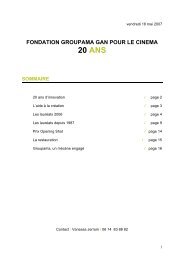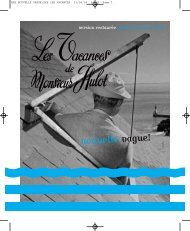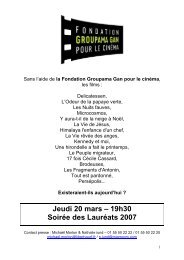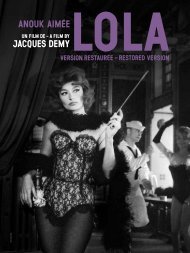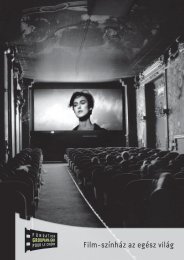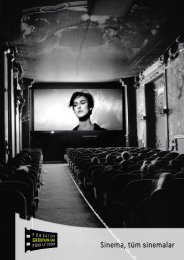duVoyage - Fondation Groupama Gan pour le Cinéma
duVoyage - Fondation Groupama Gan pour le Cinéma
duVoyage - Fondation Groupama Gan pour le Cinéma
Create successful ePaper yourself
Turn your PDF publications into a flip-book with our unique Google optimized e-Paper software.
with the help of a pen, from a film positive, the parts of the film which were to be coloured. The stencil obtained<br />
in this way was coloured one sing<strong>le</strong> colour. The operation was repeated for as many colours were needed.<br />
Then colour was applied with the aid of a cotton bud.<br />
At the beginning of 1907, the cutting out of stencils became mechanised, then, rapidly, different methods were<br />
fine-tuned to colour film, using machines that would control both the placement of the stencil and the colour<br />
application.<br />
Other <strong>le</strong>ss costly and more easily applicab<strong>le</strong> techniques were developed very early on, such as teintage (tinting)<br />
and virage.<br />
Tinting uses an acidic colourant (amaranth, direct blue, ponceau, acid green, napthol green, acid vio<strong>le</strong>t…) that<br />
uniformly penetrates the gelatine of the positive film frame, affecting only the light parts of the film. The reels<br />
were monochrome at the time and the fixed argentic image remained black in a gelatine that was entirely tinted.<br />
The colour was chosen according to the dominant ambiance required: green for landscapes, blue for night,<br />
yellow for indoor scenes...<br />
The virage technique consisted of replacing the silver metal in the positive film by a coloured salt. The colour<br />
would be more intense on the darker parts of the image, in contrast to the lighter parts, where the gelatine<br />
was almost pure.<br />
These two methods were sometimes used together, though certain films could be in part coloured and in part ‘virés’.<br />
Sp<strong>le</strong>ndid in colour!<br />
Star Film French catalogue from 1906 to 1908<br />
Star Film, like most large production houses, sold a number of shots in colour. Copies were sold either in black<br />
and white, or in colour at a higher price (doub<strong>le</strong> generally, in France and elsewhere). Georges Méliès proposed<br />
several of his hand-coloured films to his rich customers, such as the Dufayel shop, which was only interested<br />
in spectacular colour shots.<br />
It was the most visually striking, in particular the fairyta<strong>le</strong> films (féeries) that were sold in colour. Other<br />
films could however be recommended ‘for colouring’ or be qualified by the phrase ‘sp<strong>le</strong>ndid in colour’ such as<br />
<strong>le</strong> Rêve du radjah (1900) in Star Film’s American catalogue in 1908.<br />
Méliès’ films seem to have been coloured as early as 1897. From the beginning of his career he was concerned<br />
with the colours he would then apply to his films.<br />
He put in place incredib<strong>le</strong> resources to design scenery, costumes and make-up, to this end. In fact, he had the<br />
idea of painting the orthochromatic films of the time in various shades of grey to avoid having large blocks<br />
of black, opaque film which would be impossib<strong>le</strong> to colour, when it came to the colouring stage. Méliès explained<br />
his approach: “Decor is made according to the chosen model (...) and painted using glue, as on the stage;<br />
only painting is done only in shades of grey, using all the intermediary grey colours between pure black and<br />
pure white. (...). Scenery in colour comes out very badly. Blue becomes white, reds and yellows become black,<br />
like the greens ; all the effect is destroyed. The scenery needs to be painted like the backgrounds to photographs.<br />
(...) It’s best to use only specially-made objects, and carefully painted in different shades of grey,<br />
depending on what kind of objects they are. As important films are often coloured by hand before being shown,<br />
it would be impossib<strong>le</strong> to colour real photographed objects, which, if they were in bronze, mahogany, red,<br />
yellow or green cloth, would become an intense black, and thus without transparency, and it would be impossib<strong>le</strong><br />
to give to them the translucid tone necessary for projection (...). For the same reason, most costumes<br />
must be specially made in tones that come out well in photography and which can be coloured easily later (...).<br />
But here again (the artists) are not exempt from the laws governing scenery painting in which white and<br />
black alone are used. So no red on the cheeks or lips, un<strong>le</strong>ss you want to appear black. Make-up can be applied<br />
only in black and white.”<br />
«Les vues cinématographiques de Georges Méliès », Annuaire Général et International de la Photographie, Plon, Paris, 1907, p.376 et suivantes.<br />
168<br />
The colour workshop<br />
Once a film was shot, if an order for the film in colour arrived at his passage de l’Opéra, Georges Méliès would<br />
use a ‘colouring workshop’. At the time, film producers were ab<strong>le</strong> to colour their film reels in different workshops.<br />
So in 1906, Char<strong>le</strong>s Pathé possesses on rue du Bois in Vincennes, a colouring workshop that employed some<br />
200 workers, and where the work was done entirely by stencil. In the same way, Gaumont indicated in its catalogue:<br />
“We can, for a price, take charge of colouring even film reels that are not part of our col<strong>le</strong>ction.”<br />
But one of the most important workshops was undoubtedly that directed by Elisabeth Thuillier, 87 rue du Bac,<br />
in the second arrondissement of Paris. This former glass and celluloid colourist was known to be one of the<br />
best in the profession. It was not surprising then that Georges Méliès, who did not have his own colouring<br />
workshop, would turn to Elisabeth when he first started film-making.<br />
“I coloured all of M. Méliès’ films. The colouring was done entirely by hand. I had 200 peop<strong>le</strong> employed in my<br />
workshop. I passed my nights se<strong>le</strong>cting and sampling colours. In the daytime, the workers applied the colours<br />
according to my instructions. Each specialised worker took responsibility for one particular colour. There<br />
were often over twenty (specialised workers).”<br />
And on the cost of colour: «Between 6000-7000 francs per copy for a 300 metre reel, and that was before the<br />
war. We were working on average on around 60 copies for each film. Colouring by hand was quite a large proportion<br />
of a film producer’s budget.»<br />
L’Ami du Peup<strong>le</strong> (evening edition) – 13 th December 1929<br />
“The colour in Méliès’ films is to today’s films what a stained glass<br />
window is to artistic lino<strong>le</strong>um”<br />
François Mazeline, 1929<br />
Unlike the films of Pathé and Gaumont, Méliès’ films – at <strong>le</strong>ast those that E. Thuil<strong>le</strong>r dealt with – seem not<br />
to have been stencil<strong>le</strong>d. All his known colour films present image instability typical of hand-colouring, and<br />
brush strokes are c<strong>le</strong>arly visib<strong>le</strong>. However, this and the excel<strong>le</strong>nt choice and application of colour, are what<br />
makes these films unique works of art.<br />
169






